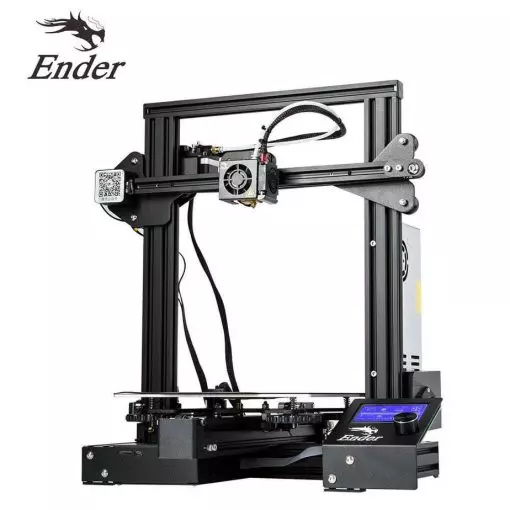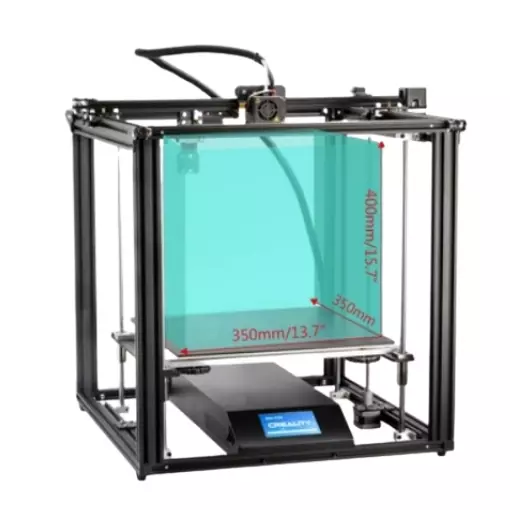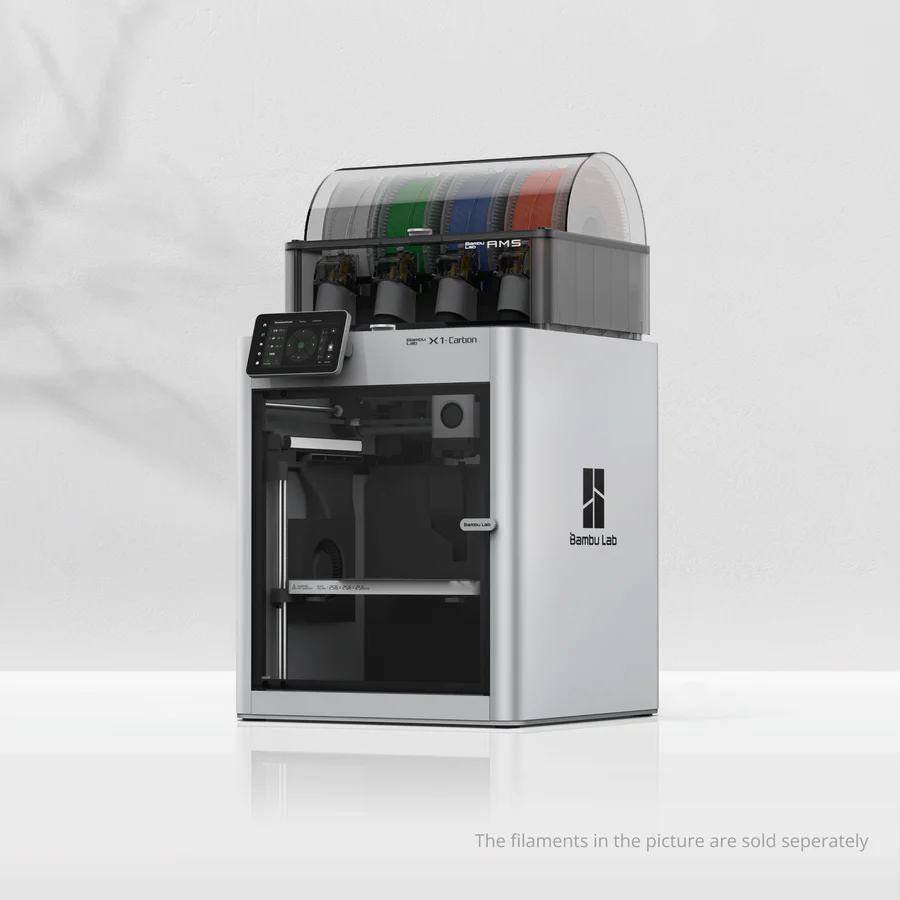Compare Ender 3 vs Ender 5 Plus vs X1 carbon
Comparison between the best 3D printers
Choose the best 3D printer at the best price. The cheapest 3D printers are here.
Buy a 3D printer here with 3D Fila.
 |
 |
 |
|
| Model | Ender 3[BUY Ender 3] |
Ender 5 Plus[BUY Ender 5 Plus] |
X1 carbon |
| Estimated price | $210,00 | $599,00 | $1449,00 |
| Fabricante | Creality 3D | Creality 3D | Bambu Lab |
| Release Year | 2018 | 2019 | 2023 |
| Print Volume [mm] | 220x220x250 | 350x350x400 | 256x256x256 |
| Printer Size [mm] | 440x440x465 | 632x619x666 | 389x389x457 |
| Weight [kg] | 6,62 | 18,2 | 14,13 |
| Power Loss Recovery | NO | YES | YES |
| Enclosed printer | NO | NO | NO |
| Bed Leveling | Manual | Automatic | Automatic |
| Filament End Sensor | NO | YES | YES |
| Bed type | Heated | Heated | Heated |
| Power supply system | Bowden | Bowden | Direct Drive |
| Standard nozzle | 0,4 | 0,4 | 0,4 |
| Maximum Nozzle Temperature [°C] | 255 | 260 | 300 |
| Maximum Bed Temperature [°C] | 110 | 100 | 120 |
| Maximum printing speed [mm/s] | 180 | 180 | 500 |
| Filament holder | YES | YES | YES |
| Camera for supervision | NO | NO | YES |
| Recommended filaments | PLA, TPU, ABS, PETG | PLA, TPU, ABS, PETG | PLA, PETG, TPU, PVA, PA, PA-CF, Nylon, PC |
| Recommended slicers | Cura, Simplify, Slic3r | Cura, Simplify, Slic3r | Bambu Studio, Super Slicer, Cura, Prusa Slicer, Orca |
| Maximum Resolution [mm] | 0,1 | 0,1 | 0,1 |
| Processor | 8 bits | 32 bits | Quad ARM A7 1.2 GHz |
| Display | Mono | Touchscreen TFT 4,3'' | Touchscreen 5'' |
| Power Supply | 24V / 270W | 24V / 504W | 350 W |
| Connectivity | SD / USB | SD / USB | Wifi, Bambu bus, Cartão SD |
| Operating systems | Windows, Mac, Linux | Windows, Mac, Linux | Windows, Linux, Macbook |
| Date of registration in the system | 2021-04-13 | 2021-04-14 | 2024-04-10 |
| Release date | 2018 | 2019 | 2023 |
| Extra features | The Ender 3 V1 is a DIY assembly 3D printer, a sales leader since 2017, standing out for its cost-benefit. With a wide printing capacity, it has a CNC machined structure for precision and stability. It offers high-precision prints with low noise, thanks to its innovative V-profile and pulleys. It has a self-adhesive magnetic platform for easy removal of models and excellent adhesion. The Ender 3 heats up quickly, reaching 100°C in 5 minutes, ideal for agile prints. It includes protection against power failures, allowing you to resume printing after interruptions, saving time and material. | The Ender 5 Plus offers a large print volume (350x350x400 mm) and fast assembly. It includes a BLTouch sensor, but with range limitations. It stands out for its dimensional accuracy, although it requires adjustments to the slicer settings. Despite the noise, its integrated design saves space, and includes features such as a filament sensor and power resumption. Ideal for large projects, it requires refinement in the settings for high-quality prints. | The Bambu Lab X1 Carbon revolutionizes 3D printing with stunning design, high print speeds, and a streamlined user experience. It stands out with its CoreXY system, a hotend capable of reaching 300°C, allowing for a wide range of filaments. Its LiDAR-assisted bed leveling system, vibration compensation, and AMS multicolor printing capability raise the industry standard. Print quality is impressive, with the ability to fine-tune for perfection. The X1 Carbon, with its closed build volume, not only promises but also delivers one of the most advanced 3D printing experiences available to consumers. |
| Support for multiple colors and materials (AMS and CFS) | NO | NO | YES |
Notes * |
|||
| Cost-benefit | 6 / 10 | 6 / 10 | 7 / 10 |
| Hardware | 0.5 / 10 | 2 / 10 | 6.4 / 10 |
| Screen | . | . | . |
| Print volume | 3 / 10 | 4 / 10 | 4 / 10 |
| Performance | 1 / 10 | 1 / 10 | 4 / 10 |
| [BUY Ender 3] | [BUY Ender 5 Plus] |
Conclusion |
| In conclusion, when comparing the Ender 3, Ender 5 Plus, and Bambu Lab X1 Carbon 3D printers, distinct advantages and trade-offs emerge based on their features and price points. The Ender 3 stands out as an excellent entry-level option, offering remarkable cost-effectiveness and ease of use for beginners. Its compact design, decent print size, and effective performance make it a solid choice for hobbyists or those looking to try 3D printing without a significant financial commitment. However, it lacks some advanced features like power loss recovery and automatic bed leveling, which limits its usability for more complex projects. On the other hand, the Ender 5 Plus provides a larger print volume and more advanced features, including automatic bed leveling and a filament sensor. While it is pricier than the Ender 3, it justifies the cost with its improved accuracy and user-friendly adjustments. It is suitable for users who are looking for a mid-tier option that caters to larger prints but still requires some hands-on involvement for optimal performance. Finally, the Bambu Lab X1 Carbon emerges as a high-end option with cutting-edge features such as a high-temperature hotend, advanced bed leveling, and multicolor printing capabilities. Its premium design, exceptional speed, and versatility make it an impressive choice for professional users or serious enthusiasts. Though its price is significantly higher, it offers a comprehensive suite of features that can significantly enhance the 3D printing experience. Ultimately, the choice between these models will depend on the user's specific needs, budget, and desired features. Beginners may find the Ender 3 most appealing, while users looking for a balance of functionality without breaking the bank may gravitate towards the Ender 5 Plus. Conversely, those seeking the latest technology and performance capabilities may prefer the Bambu Lab X1 Carbon, despite the higher investment. |

